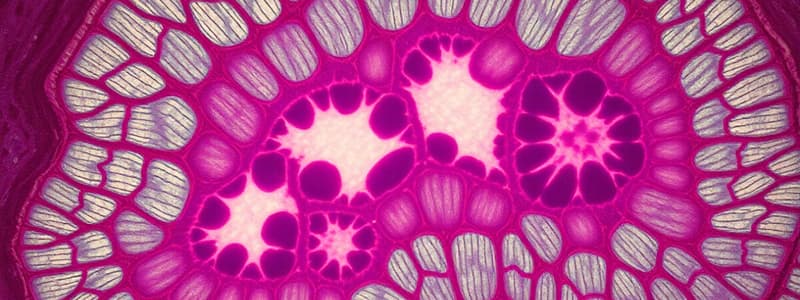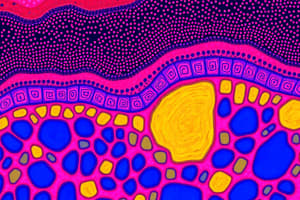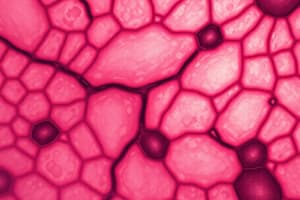Podcast
Questions and Answers
What is a defining characteristic of epithelial tissue?
What is a defining characteristic of epithelial tissue?
- It consists of loosely arranged cells.
- It has a basement membrane only in stratified types.
- It is avascular and receives nutrients through diffusion. (correct)
- It is highly vascularized.
Which domain of an epithelial cell faces the lumen or external environment?
Which domain of an epithelial cell faces the lumen or external environment?
- Basal Domain
- Lateral Domain
- Apical Domain (correct)
- Ciliary Domain
Which type of epithelium consists of multiple layers of cells?
Which type of epithelium consists of multiple layers of cells?
- Stratified epithelium (correct)
- Simple epithelium
- Transitional epithelium
- Pseudostratified epithelium
What shape does cuboidal epithelium exhibit?
What shape does cuboidal epithelium exhibit?
Pseudostratified epithelium appears stratified due to what feature?
Pseudostratified epithelium appears stratified due to what feature?
What is a key feature of transitional epithelium?
What is a key feature of transitional epithelium?
Which type of epithelial cells line blood vessels?
Which type of epithelial cells line blood vessels?
What distinguishes the basal domain of an epithelial cell?
What distinguishes the basal domain of an epithelial cell?
Which of the following correctly describes microvilli?
Which of the following correctly describes microvilli?
What is a distinct structural characteristic of stereocilia?
What is a distinct structural characteristic of stereocilia?
Which axoneme structure is associated with motile cilia?
Which axoneme structure is associated with motile cilia?
Which protein is responsible for connecting the actin filaments to the plasma membrane in microvilli?
Which protein is responsible for connecting the actin filaments to the plasma membrane in microvilli?
Which statement is true regarding primary cilia?
Which statement is true regarding primary cilia?
What is the role of the terminal web in microvilli?
What is the role of the terminal web in microvilli?
Which type of cilia is responsible for generating left-right asymmetry during embryonic development?
Which type of cilia is responsible for generating left-right asymmetry during embryonic development?
Which of the following cells would contain microvilli enhancing absorption?
Which of the following cells would contain microvilli enhancing absorption?
What is a key composition difference between microvilli and cilia?
What is a key composition difference between microvilli and cilia?
Flashcards
What is epithelial tissue?
What is epithelial tissue?
Epithelial tissue is a type of tissue that covers the surfaces of organs and lines body cavities. It is made up of closely packed cells that are connected by specialized junctions.
What is the blood supply of epithelial tissue?
What is the blood supply of epithelial tissue?
Epithelial tissue is avascular, which means it does not have blood vessels. It receives nutrients and oxygen from underlying connective tissue through diffusion.
What supports epithelial tissue?
What supports epithelial tissue?
Epithelial tissue is always supported by a layer of connective tissue called the basement membrane. This membrane provides structural support and acts as a barrier.
What is epithelial cell polarity?
What is epithelial cell polarity?
Signup and view all the flashcards
What is simple epithelium?
What is simple epithelium?
Signup and view all the flashcards
What is stratified epithelium?
What is stratified epithelium?
Signup and view all the flashcards
What is pseudostratified epithelium?
What is pseudostratified epithelium?
Signup and view all the flashcards
What is transitional epithelium?
What is transitional epithelium?
Signup and view all the flashcards
Microvilli
Microvilli
Signup and view all the flashcards
Cilia
Cilia
Signup and view all the flashcards
Stereocilia
Stereocilia
Signup and view all the flashcards
Terminal Web
Terminal Web
Signup and view all the flashcards
Basal Body
Basal Body
Signup and view all the flashcards
Axoneme
Axoneme
Signup and view all the flashcards
Dynein
Dynein
Signup and view all the flashcards
Simple Columnar Epithelium
Simple Columnar Epithelium
Signup and view all the flashcards
Goblet Cells
Goblet Cells
Signup and view all the flashcards
Basement Membrane
Basement Membrane
Signup and view all the flashcards
Study Notes
Epithelial Tissue
- Epithelial tissue forms a protective covering of body surfaces and lines body cavities.
- It's avascular; nourished by diffusion from underlying connective tissue.
- It always rests on a basement membrane, a specialized type of connective tissue.
- Cells display polarity (structural and functional differences between sides).
Epithelial Cell Polarity
- Apical Domain: Faces the lumen or external environment; possesses microvilli, cilia, stereocilia.
- Lateral Domains: Contact adjacent cells; responsible for cell-to-cell adhesion.
- Basal Domain: Faces the basement membrane; attaches to it, facilitates nutrient transport.
Epithelial Tissue Classification
- Simple epithelium: Single layer of cells.
- Stratified epithelium: Multiple layers of cells.
Classifying Epithelial Cells Based on Shape
- Squamous epithelium: Flattened cells, width greater than height.
- Cuboidal epithelium: Cube-shaped cells, equal height and width.
- Columnar epithelium: Tall, column-shaped cells, height greater than width.
Pseudostratified Epithelium
- Appears stratified due to varying cell heights and nuclei positions.
- All cells connect to the basement membrane.
- Primarily pseudostratified columnar epithelium, found in the respiratory system..
Transitional Epithelium
- Also known as urothelium, found in the ureters, bladder, urethra.
- Stratified epithelium where the top layer of cells changes shape based on organ distension.
- Top layer (umbrella cells) covers underlying cells.
Specialized Epithelial Cells
- Endothelial cells: Simple squamous, line blood vessels.
- Mesothelial cells: Simple squamous, cover organ surfaces.
Apical Domain Modifications
- Microvilli: Finger-like projections increasing surface area for absorption; found in intestines (striated border), kidneys (brush border).
- Cilia: Hair-like projections moving substances along the cell surface; found in the respiratory system.
- Stereocilia: Long, non-motile microvilli found in the inner ear and the male reproductive system.
Microvilli Structure and Proteins
- Core: Contains 20-30 parallel actin filaments.
- Actin Filaments: Connected by fimbrin, villin, and fascin.
- Myosin I: Links actin filaments to the plasma membrane
- Villin: Maintains actin filament arrangement at the microvillus tip.
- Terminal Web: Anchoring structure; composed of cross-linked actin filaments and myosin II.
Microvilli, Stereocilia, and Cilia
-
Microvilli:
- Projections of the apical domain for increased absorption.
- Contain actin filaments, connected by fimbrin, villin, fascin.
- Myosin I links actin to the membrane; villin anchors the core.
- Terminal web anchors at the base, composed of cross-linked actin filaments, and myosin II.
-
Stereocilia:
- Highly modified microvilli, found in epididymis (absorb testicular fluid).
- Actin filaments with alpha-actinin, but no villin.
- Ezrin connects actin filaments to the plasma membrane
- They do not contract due to the absence of myosin, in contrast to microvilli.
-
Cilia:
- Hair-like structures responsible for movement.
- Composed of microtubules in a 9+2 axoneme arrangement; 9 peripheral doublets & 2 central microtubules.
- 9+0 axoneme is also possible
- Dynein: Motor protein involved in cilia motion.
- Basal body: Microtubule organizing center located in the apical domain
Types of Cilia
-
Motile Cilia:
- 9+2 axoneme and dynein, moving substances.
- Abundant in respiratory system to clear mucus/foreign material.
-
Primary Cilia:
- 9+0 axoneme, non-motile; sensory function.
-
Nodal cilia:
- 9+0 axoneme and dynein. Development of left/right body symmetry.
Other Relevant Tissues and Structures
-
Simple Columnar Epithelium:
- Single layer columnar cells found in the small intestine; possess a brush border (microvilli).
- Goblet cells: Mucus-secreting cells, appear empty in H&E after clearing. PAS staining highlights them
-
Mesentery:
- Tissue covering small intestines; composed of mesothelial cells; visible in Silver & H stains (silver stains lipids)
-
Blood vessels:
- Endothelial cells (simple squamous) lining blood vessels.
- Veins appear collapsed in H&E staining
-
Lymphatic vessels:
- Lined by endothelial cells, do not contain red blood cells.
-
Basement membrane: A thin, red line underneath the epithelium in H&E staining.
-
Terminal web: At the base of microvilli, composed of cross-linked actin filaments and myosin II. Not present under cilia.
Studying That Suits You
Use AI to generate personalized quizzes and flashcards to suit your learning preferences.




